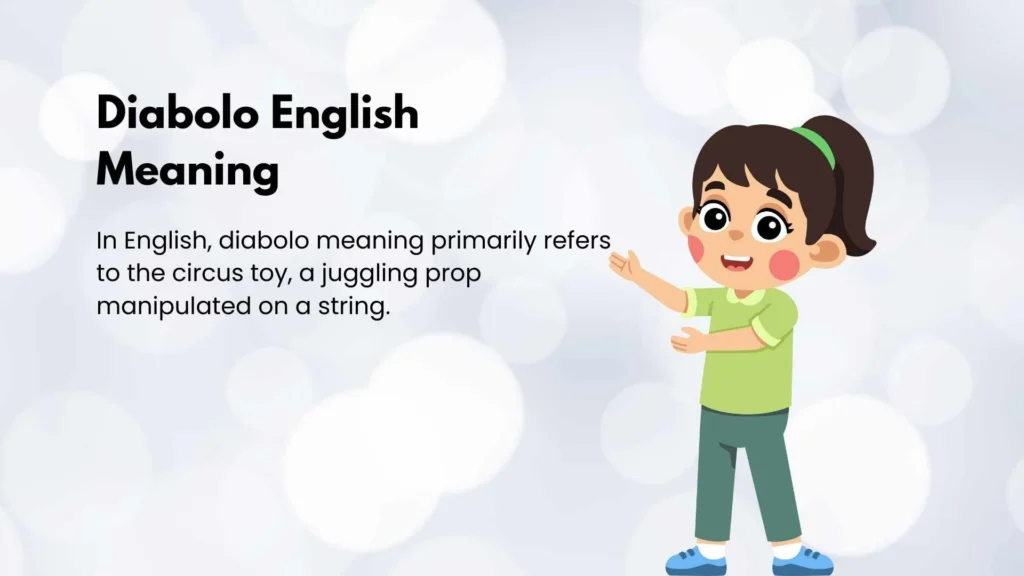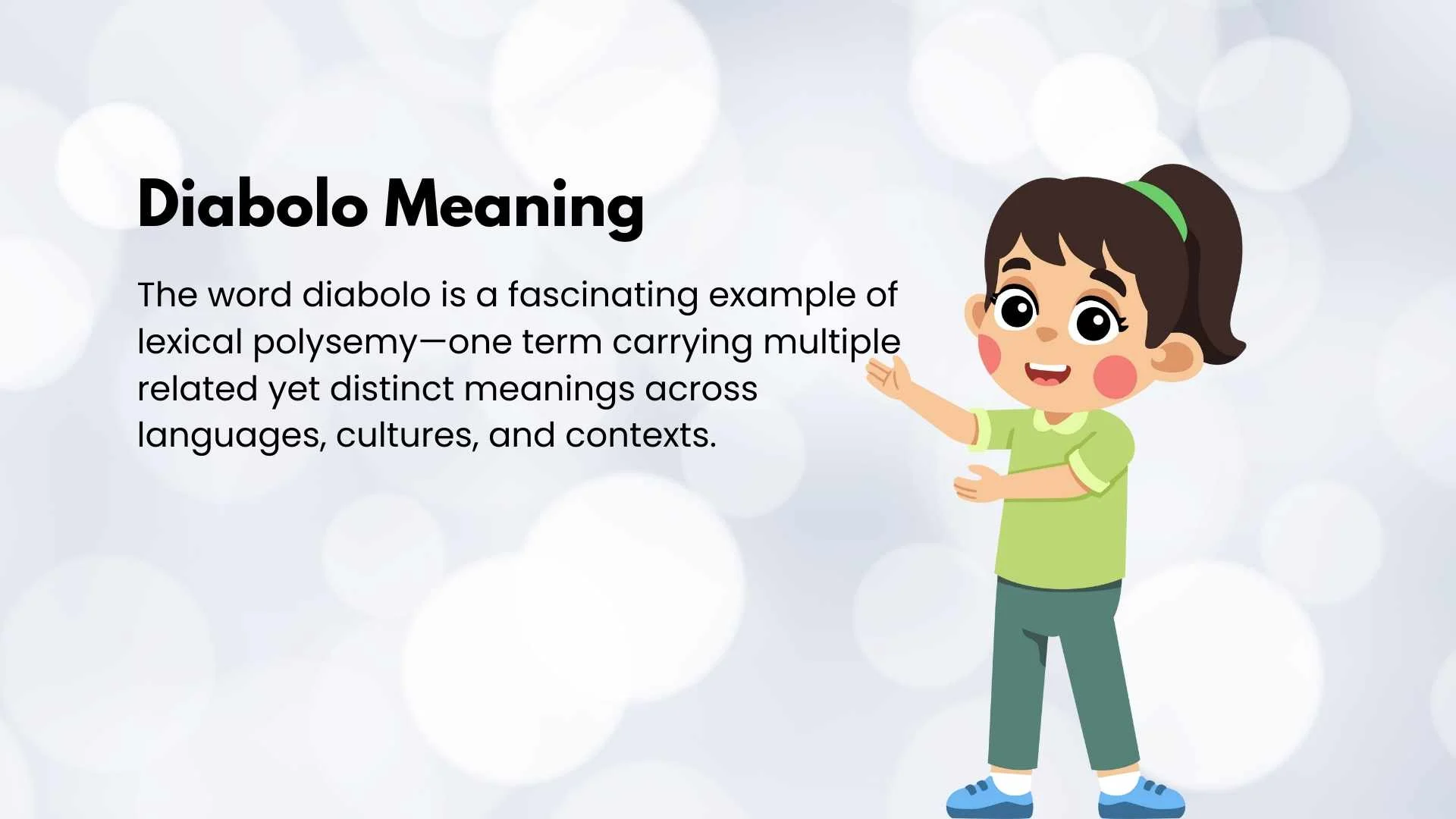The word diabolo is a fascinating example of lexical polysemy—one term carrying multiple related yet distinct meanings across languages, cultures, and contexts.
Rizz Line Generator
From a juggling toy in circuses to a refreshing French café drink, and from a fashion term describing a flared waistline to playful slang, diabolo demonstrates how a single word can evolve over centuries, gaining new life in different spheres.
This article dives into the diabolo meaning, exploring its origins, translations, and cultural contexts, shedding light on nuances often overlooked.
Etymology and Origins of the Word Diabolo
Understanding diabolo etymology begins with its Greek roots. The word derives from dia meaning “across” or “through” and ballo meaning “to throw.” Essentially, diabolo translates to “throw across,” a description perfectly suited for the circus toy, a spinning prop tossed and manipulated on a string.
Historically, the juggling toy as we know it today was popularized in the early 20th century, although similar spinning devices have existed for centuries in various cultures, including the Kongzhu, a Chinese spinning top.
French performers in the 19th century refined the modern diabolo and made it a staple in circus arts, emphasizing skill, balance, and dexterity.
Interestingly, the word is often mistakenly linked to “diablo,” the Spanish word for devil. While the spelling is similar, diabolo polysemy is entirely separate, originating from throwing motions rather than infernal connotations.
Key Historical Facts:
- Greek roots: dia (“across”) + ballo (“to throw”)
- Popularized in France during the 19th century
- Modern design solidified by Gustave Phillippart in the early 1900s
Diabolo English Meaning

In English, diabolo meaning primarily refers to the circus toy, a juggling prop manipulated on a string. It’s sometimes described as a “yo-yo on steroids,” emphasizing its trick and flashy potential. Performers toss it, spin it, and execute intricate tricks that require balance and duality, showcasing both skill and artistry.
Examples in English Context:
- “He spent hours perfecting his diabolo juggling skills, mastering tricks no beginner could attempt.”
- “The diabolo twirled across the stage, catching the audience’s eye with its hypnotic motion.”
Beyond the toy, English usage sometimes adopts figurative senses, symbolizing control, balance, or duality, often in creative writing or metaphors.
Diabolo Spanish Meaning (“Diábolo”)
In Spanish, the term becomes diábolo, preserving the toy-related meaning but also presenting translation challenges due to its similarity with diablo (devil). This leads to frequent translation misconceptions, particularly among learners of Spanish.
Practical Examples in Spanish:
- “El diábolo requiere paciencia y coordinación para dominarlo.” (“The diabolo requires patience and coordination to master.”)
- “Muchos confunden diábolo con diablo, pero son palabras distintas.” (“Many confuse diábolo with diablo, but they are distinct words.”)
In Latin American Spanish, the toy is less common, but the term is understood among circus enthusiasts and those familiar with European performance traditions.
Diabolo French Meaning

France plays a central role in shaping diabolo cultural contexts. Beyond its circus roots, in French, diabolo also refers to a popular café drink, combining soda with flavored syrups such as:
- Diabolo menthe (mint)
- Diabolo fraise (strawberry)
- Diabolo grenadine (grenadine syrup)
French Usage Examples:
- “Au café, j’ai commandé un diabolo menthe bien frais.” (“At the café, I ordered a refreshing diabolo menthe.”)
- “Le diabolo est un symbole de l’été dans la culture café française.” (“The diabolo is a summer symbol in French café culture.”)
This dual meaning—a toy and a beverage—is a prime illustration of polysemy in language and demonstrates how context shapes interpretation.
Diabolo in Fashion and Corsetry

In fashion, the diabolo corset waist refers to a specific waistline silhouette: narrow at the midsection but flaring at the chest and hips. This shape emphasizes an hourglass figure and was prominent in Victorian fashion. Designers used the term diabolo to evoke the dynamic, flared motion reminiscent of the toy spinning through space.
Examples of Diabolo in Fashion:
- A 19th-century dress with a diabolo waist accentuated the wearer’s hourglass figure, creating a dramatic silhouette.
- Modern couture occasionally references diabolo-inspired shapes, blending historical form with contemporary elegance.
Visual Diagram Suggestion:
Chest
\
\
Waist (narrow) -----> Diabolo Corset Waist
/
/
Hips
Diabolo in Slang and Urban Dictionary
In contemporary slang, particularly in online communities and Urban Dictionary, diabolo slang meaning often refers to a playful, tricky, or flashy object. It can describe:
- A mischievous person
- A yo-yo on steroids (figuratively)
- Anything that requires dexterity and flair
Examples in Slang:
- “She’s a real diabolo, always surprising everyone with creative pranks.”
- “That new juggling trick is pure diabolo energy—impossible to ignore.”
This metaphorical usage highlights the symbolic meaning of balance, duality, and skill associated with the original circus toy.
Diabolo Symbolic Meaning and Cultural Contexts
Across contexts, diabolo symbolic meaning often conveys balance, duality, and creative mastery. The spinning toy embodies the delicate equilibrium between motion and control, making it a natural art metaphor. Artists, performers, and even tattoo enthusiasts adopt diabolo symbolism to signify:
- Precision and focus
- Harmony between opposing forces
- Creativity and adaptability
Cultural Examples:
- In circus performance, the diabolo demonstrates physical balance and coordination.
- In French cafés, the diabolo drink reflects a cultural blend of tradition and playful refreshment.
- In fashion, the diabolo waist emphasizes visual balance and elegance.
Common Misconceptions About Diabolo
Despite its clear etymology, diabolo is often misunderstood:
- Confusion with Diablo (Spanish) – People mistakenly associate it with “devil,” which is false.
- Assuming toy-only meaning – In French, it can mean a beverage; in fashion, a waistline.
- Overlooking figurative or slang usage – Diabolo represents creativity, flair, and mischief in various subcultures.
Correcting these misconceptions requires understanding contextual usage, linguistic semantics, and cultural backgrounds.
Quick Reference: Summary Table of Diabolo Meanings
| Context / Culture | Meaning | Examples |
|---|---|---|
| English | Circus toy, juggling prop | “He mastered the diabolo trick.” |
| Spanish | Diábolo (toy) | “El diábolo es difícil de manejar.” |
| French | Toy & café drink | “Un diabolo menthe s’il vous plaît.” |
| Fashion | Diabolo corset waist | Victorian hourglass figure dresses |
| Slang | Playful, tricky, flashy | Urban Dictionary: “She’s a diabolo!” |
| Symbolism | Balance, duality, creativity | Tattoo art, performance metaphors |
Diabolo Across Cultures: Why Context Matters
Diabolo cultural contexts show how a single word can evolve differently:
- France: Toy and café beverage
- Spain/Latin America: Mostly toy, sometimes misunderstood
- English-speaking countries: Toy, metaphorical usage
- Fashion history: Victorian waistlines and modern design interpretations
This cross-cultural variation underscores the importance of context. A polysemous word like diabolo illustrates how meaning is shaped by linguistic semantics, cultural semantics, and practical usage.
Conclusion
The term diabolo is far more than a circus toy or a café drink. Its rich etymology and polysemy make it a linguistic gem, illustrating the interplay between culture, context, and symbolism.
Whether referring to a juggling prop, a refreshing French beverage, a fashion silhouette, or a playful slang term, diabolo demonstrates the beauty of contextual meaning in language.
By understanding diabolo translations, cultural contexts, and figurative uses, we appreciate not just the word itself, but how language evolves in fascinating, interconnected ways.
FAQ Section
What does diabolo mean?
- Diabolo is a polysemous word with multiple meanings, including a juggling toy, a French café drink, a fashion term for waist shape, and a playful slang term.
What is the diabolo meaning in Spanish?
- In Spanish, diábolo generally refers to the toy. It is sometimes confused with diablo (devil), but they are unrelated.
What is the diabolo meaning in French?
- In French, diabolo can refer to a toy or a café drink, such as diabolo menthe, diabolo fraise, or diabolo grenadine.
What does diabolo mean in fashion?
- Diabolo fashion meaning refers to a flared waistline, also called a diabolo corset waist, emphasizing the hourglass figure popular in Victorian fashion.
What is the diabolo slang meaning?
- In slang, diabolo represents something flashy, tricky, or playful, often likened to a “yo-yo on steroids.” It appears in Urban Dictionary diabolo entries as a metaphor for creativity or mischief.




